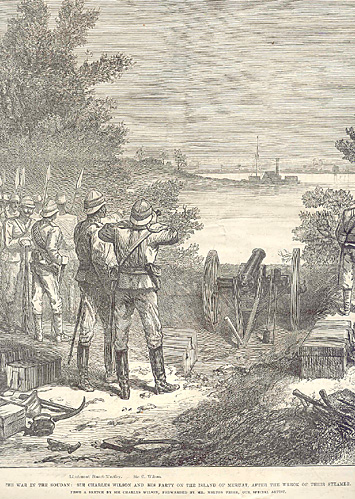January 30th
The nuggar was fitted with large sweeps, and went ahead thought the next cataract, scouting the passage for Bordein, which passed safely. They then passed through the gorge, which was again undefended. Before the next and most dangerous cataract, they stopped to lighten the boats as much as possible. Again the nuggar passed through safely, but a strong headwind pushed Bordein onto rocks, and it was only with a mighty effort they managed to get her off.
The next cataract was very narrow and rocky, but Bordein passed safely stern first, lowered down on hawsers attached to anchors or rocks. The boat moved by inches, controlled by the hawsers and the engine running forward. It was a slow and anxious process, and the boats anchored for the night soon after, in mid-stream to prevent night attacks.
Sir C. Wilson (with binoculars) and Lt. Stuart Wortley (pointing) on the island of Meurat after the wreck of their steamer. (From a sketch by Wilson forwarded by Melton Prior, special artist).
January 31st
Bordein was lowered down the next cataract in the same manner as the previous day. Then Bordein and the nuggar stopped for wood, as the supply was very low, all the reserve as well as empty ammunition cases had been burnt. Wilson prepared to run past the expected batteries at Wad Habashi, but the Bordein never made it that far. Just after passing the next cataract safely, she struck a submerged rock and began to take in water rapidly. The captains managed to reach a sand spit at the end of a small wooded island and ran the Bordein aground there. Fifty yards beyond lay the larger island of Mernat. Despite all efforts the Bordein was finished. Men, guns, ammunition and stores were landed on the island.
As soon as it was dark Wilson sent Wortly in a small boat downriver to bring help from Gubat. He took a crew of four English soldiers and eight natives, and safely passed the Wad Habashi battery, despite having three volleys fired at them from the two guns now positioned there. Wortley’s boat reached Gubat at 3am the next day, having covered nearly forty miles in just over eight hours.
Wilson had planned to march towards Gubat by night, but could not get his demoralised native troops to move.
Stewart's Dash to Khartoum The Final Attempt to Relieve General Gordon Part II
- January 28
January 29
January 30-31
February 1-3
February 4 and Bibliography
Orders of Battle
Gaming the Action
Models, Terrain, and Tactics
Part I
Stewart's Dash to Khartoum The Final Attempt to Relieve General Gordon
Back to The Heliograph # 140 Table of Contents
Back to The Heliograph List of Issues
Back to Master Magazine List
© Copyright 2003 by Richard Brooks.
This article appears in MagWeb.com (Magazine Web) on the Internet World Wide Web.
Other articles from military history and related magazines are available at http://www.magweb.com
